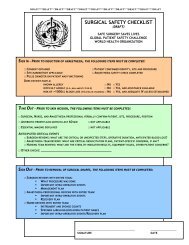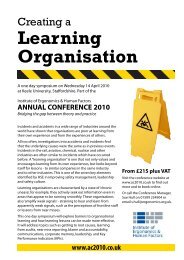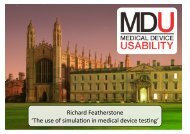The Essentials of Patient Safety - Clinical Human Factors Group
The Essentials of Patient Safety - Clinical Human Factors Group
The Essentials of Patient Safety - Clinical Human Factors Group
Create successful ePaper yourself
Turn your PDF publications into a flip-book with our unique Google optimized e-Paper software.
<strong>The</strong> <strong>Essentials</strong> <strong>of</strong> <strong>Patient</strong> <strong>Safety</strong><br />
analyses <strong>of</strong> different types <strong>of</strong> incidents undertaken, alongside a variety <strong>of</strong> other<br />
national initiatives. <strong>The</strong> technical and analytic challenges <strong>of</strong> such a system are<br />
considerable, as it deals with simply staggering numbers <strong>of</strong> incidents; by early 2009<br />
the database contained over 3 million incidents in total most <strong>of</strong> which, <strong>of</strong> necessity,<br />
have not been subject to any formal analysis.<br />
Reporting systems were established in response to the scale <strong>of</strong> harm revealed<br />
by case record review studies. <strong>The</strong> studies had shown the underlying problem;<br />
reporting systems were meant to provide information about adverse events on an<br />
ongoing basis. However incident reporting systems are actually very poor at<br />
detecting adverse events (20). For example Sari and colleagues (21) carried out a<br />
classical case record review <strong>of</strong> 1000 records and compared the findings with locally<br />
reported incidents. <strong>The</strong> reporting system detected only 5% <strong>of</strong> adverse events<br />
discovered by reviewing records. This means that voluntary reporting systems are<br />
pretty useless as a means <strong>of</strong> measuring harm. However, as we will see, they can be<br />
valuable as a means <strong>of</strong> surfacing safety issues in order to learn about the<br />
vulnerabilities <strong>of</strong> the system.<br />
Analysis, feedback and action from reporting systems<br />
<strong>The</strong> real meaning and importance <strong>of</strong> incidents is apparent only in the narrative. To<br />
make real sense <strong>of</strong> an incident you must have the story and, furthermore, the story<br />
must be interpreted by someone who knows the work and knows the context. <strong>The</strong><br />
implication <strong>of</strong> this is that if healthcare incident reports are to be <strong>of</strong> real value they<br />
need to be reviewed by clinicians and, ideally, also by people who can tease out the<br />
human factors and organisational issues. One <strong>of</strong> the main problems that healthcare<br />
faces is that the number <strong>of</strong> reported incidents is so vast in mature systems that only a<br />
minority <strong>of</strong> incidents can be reviewed by those with relevant expertise (20).<br />
It is impossible to analyse all reports in detail and for common incidents<br />
largely pointless; better to analyse a small number <strong>of</strong> reports in depth than carry out a<br />
cursory analysis <strong>of</strong> a large number which <strong>of</strong>ten produces little more than a few bar<br />
charts. Once analysis has been carried out though, there are various ways in which<br />
action can be taken. Some issues are only <strong>of</strong> concern in a particular unit, faulty<br />
equipment for instance or a system <strong>of</strong> handover within that unit. Others need action<br />
across an organisation if, for instance, staffing levels are shown to be inadequate.<br />
Feedback that is restricted to a local system or specialty is attractive because it can be<br />
rapid and because it is being shared within a community <strong>of</strong> experts who understand<br />
the significance <strong>of</strong> the incident and the lessons it conveys. However some safety<br />
issues, such as the design <strong>of</strong> equipment or drug packaging, cannot easily be addressed<br />
by any single organisation and need action at a regional or national level.<br />
Reporting will always be important, but has been overemphasised as a means<br />
<strong>of</strong> enhancing safety. <strong>The</strong> fact that only a small proportion <strong>of</strong> incidents are reported is<br />
not, in my view, critically important. As long as the system receives sufficient reports<br />
to identify the main safety issues the absolute number <strong>of</strong> reports is not critical.<br />
Reporting systems serve an important function in raising awareness and generating a<br />
culture <strong>of</strong> safety as well as providing data. However the results <strong>of</strong> reporting are <strong>of</strong>ten<br />
misunderstood in that they are mistakenly held to be a true reflection <strong>of</strong> the<br />
underlying rate <strong>of</strong> errors and adverse events. Incident reporting is crucial, but is only<br />
one component <strong>of</strong> the whole safety process. Incident reports in themselves are<br />
primarily flags and warnings <strong>of</strong> a problem area. Once collected however they must be<br />
analysed and understood which is the subject <strong>of</strong> the next chapter.<br />
15








